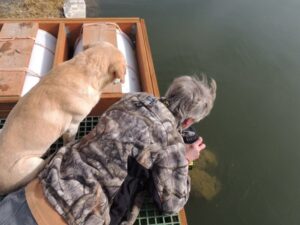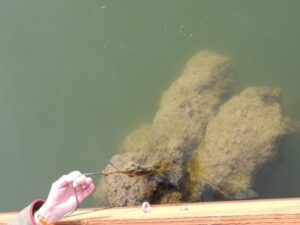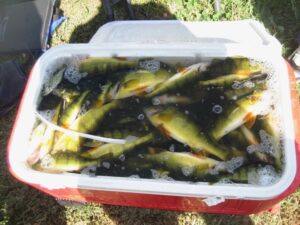
We thank Bruce Kania, CEO of Floating Island International, for his contributed article! If you are interested in the concepts presented below, Bruce's contact information is provided below.
I’m Bruce Kania, a historian by education, an environmentalist by passion, and I run a company called Floating Island International. I also have the luxury of a 6.5-acre research reservoir to manage. Here in Montana, this 52-acre-feet reservoir is considered private water, so I have a wide range of management authority over it. Combine the above with one of my very favorite pastimes, fishing, and you can imagine how much fun I’ve had over the last 21 years! We named our reservoir Fish Fry Lake in honor of its productivity and tasty fish production, but above all it has been a living classroom.
The culmination of what I’ve learned is that reservoirs, large and small, are poised to play a major role in mitigating climate change.
Looking back on their history helps to understand why these water bodies are in this unique position. How many reservoirs were in place when the first European settlers landed in North America? Whether it was cod fisherman who settled in St. John’s, Newfoundland, or the Spanish in St. Augustine, Florida, the answer is probably only a few, plus those immediately around Mexico City in the far south of this continent. Eventually sawyers in New England and Eastern Canada began to harness the power of water and gravity. And the race was on. Dams became a wonderful investment. And eventually, as irrigation developed, the additional value of water for growing crops and inventorying water for major urban sites added another big value proposition. Today, dams generate hydroelectric power, irrigation water, and drinking water all over North America. Perhaps the last kid on the block has been recreation, of which fishing plays a major role. Fishery enhancement brings with it another surprising value however. As reservoirs are enhanced for fish, a major source of methane can be reduced.
Reservoirs store heat, and many receive influxes of nutrients from agricultural sources. This potent mix makes life particularly interesting for reservoir managers, as many of you have experienced. I have too, as Fish Fry Lake receives surges of agricultural nutrients that can put it into hyper-eutrophic status, a recipe for harmful algae blooms, near monocultures of other aquatic vegetation, and corresponding dissolved oxygen deficits. Opportunistic life forms that include cyano bacteria, blue-green algae, and aquatic vegetation - non-native and native alike – can explode in boom-and-bust cycles, sometimes more than once a season. The resulting organic mass dies and settles to the bottom, where it is broken down by microbes, and oxygen is used up. Fish and other air breathing biota can’t survive in this zone of oxygen-poor water. But microbes that generate methane do live and prosper here, especially within the benthic sludge and sediment.
In a healthy, oxygen-rich aquatic environment, nutrients cycle into fish. In a system with too many nutrients and insufficient oxygen, the same nutrients result in methane. A research team consisting of academic and EPA scientists modeled that a whopping 50% of all methane releases come from nutrient-impaired freshwater across the planet (Beaulieu, 2019); and a Yale group calculated that 12% of all greenhouse gas emissions are from methane released by impaired freshwater (Rosentreter, 2021).
As an environmental historian, I want to mention that this cycle, this downward spiral, has occurred before. It was eons ago, and the event, sometimes referred to as the “Great Extinction” was triggered by a geothermal disruption that released huge volumes of carbon dioxide and caused Earth’s atmosphere to warm by 10 degrees Centigrade (Mays, 2022).
Human innovation is a new variable relative to earth’s history. While our ingenuity may be the ultimate cause of today’s climate crisis, it also has the potential to interrupt the current cycle, so that instead of experiencing a 10oC upward swing, we may limit it. The international goal is a maximum of 1.5oC; we are currently about 1.2oC. Here’s the rub though: we’ve achieved this 1.2oC change in a mere 300 years. This means we are on pace to hit or even exceed a 10oC rise dramatically faster than in the previous event which occurred over 300,000 years!
From my perspective, there is hope. Human innovation can reduce methane generation: in fact, technologies already exist to achieve this, and scaling them to even the largest settings is doable.
Grow Fish Instead of Algae
The key to preventing methane emissions from nutrient impaired waterways is oxygen. Even a very low level of oxygen - just a fraction of 1 part per million - is enough to sustain a class of microbe that consumes methane (Thottathil, 2019). These microbes, called “methanotrophs”, can proliferate above methanogens in the top layer of sludge on the bottom of waterways, and if they can be nurtured, they represent a methane-consuming barrier, a lid of sorts. And these guys are biofilm generators. Biofilm is a sticky material that adheres to any submerged surface area. It bonds with suspended solids that are always present in freshwater to form a substance called periphyton. Periphyton plays a major role near the base of food webs for countless lifeforms. Periphyton is an alternative to cyanobacteria and monocultures of blue/green algae. Whereas these algae can result in disastrous environmental swings, periphyton is invariably at the base of healthy food webs that grow fish and ultimately generate a net positive dissolved oxygen level, in large part due to another ancient form of phytoplankton, the diatoms.


Under low light conditions, such as the bottom of deep reservoirs, diatoms occur. They can be free floating, but also occur in periphyton, where they generate oxygen without becoming an unhealthy monoculture. If we were to sample benthic water and sediment from a healthy waterway far removed from nutrient impairment, we would find diatoms. Conversely, we would be hard pressed to find cyanobacteria or high concentrations of blue/green algae.
Reservoirs that are managed to prevent oxygen deprivation are great candidates for exceptional fisheries. For example, even though Fish Fry Lake experiences surges of nutrients from farm runoff that put it in hyper-eutrophic status, we manage it to be a productive fishery by providing surface area for periphyton development and introducing oxygen into the seasonally stratified benthic zone. If you’re interested in viewing the impact this strategy can have on a fishery check out the FII YouTube channel (and please subscribe!).
Fish Fry Lake, which is only 25 feet deep, is where we are designing and testing innovative new methods of oxygenation. Our research includes a floating island that supports a mechanical system to lift and oxygenate stratified benthic water and return it to its original depth without temperature change. We are working towards an autonomous solar-powered embodiment of this airlift system that can oxygenate methane emitting hotspots - deep points in reservoirs where sludge accumulates and oxygen demand is high. Today, these hypoxic zones do not support fish, but if our airlift system does what we expect, accumulated nutrients present in this deep water can be turned into that fish-food of nature, periphyton, and dead water can be oxygenated and teeming with fish again. We are staging for a demonstration project at a methane emitting hotspot on a regional reservoir that is 430 feet deep, with a system that can oxygenate as much as 7,000 acre-feet of water per day to that optimal 0.2 ppm level preferred by methanotrophs.
To summarize, this is our vision for how we can reduce and prevent methane emissions and turn dead water into an oxygen-rich environment to support a thriving fishery:
- restoring / maintaining aerobic status into the top layer of a reservoir’s benthic sludge
- sustaining methanoTROPHs across that top layer of sludge (the lid)
- shutting down the methanoGENs
- increasing bio-digestion of the organic fraction of benthic sludge (by methanotrophs)
- fishery enhancement through growth of healthy periphyton
- preventing harmful algae blooms, through nutrient abatement, explained below
An oxygenated benthic system will accumulate sediment at a far slower rate than one that is oxygen-deprived, or hypoxic. This is because oxygenated systems cycle nutrients at least 4.5 times faster than hypoxic systems (Stewart, 2008). Every time a nutrient is cycled into a living molecule, it will tie up at least one phosphorus cell, sixteen nitrogen cells, and 106 carbon cells (the Redfield Ratio). By maintaining year-round oxygenation status in our reservoirs, we can extend their life: we can slow down eutrophication, as nutrients cycle into living, harvestable biota (such as fish) instead of sludge.

Revenue Opportunity
The recently passed Inflation Reduction Act (IRA) got down to brass tacks in connection with methane credits. The Act specifies the value of methane prevention on a graduated scale, ultimately establishing the value at $1,500/ton (as of 2026). While the act doesn’t specifically address biogenic methane but instead focuses on methane that emits from the oil and gas industry, it’s clear from the research that biogenic methane is just as important to mitigate. NOAA has 50 methane tracking stations around the world, and the data they generate show that biogenic methane is expanding, while industrial methane is relatively stable and even declining (Tollefson, 2022).
If 2026 seems a long way off, bear in mind that measurement can (and must) start now to establish baselines for credits, while the monetization process is being worked out. There is a lot of room for development of tools and methodologies to facilitate before-and-after measurement, but there are reliable technologies that can be deployed today.
Reservoir managers are uniquely positioned to claim methane credits. If clear and empirical methane reduction can be established, we can legitimately market methane credits with which to fund stewardship projects that will transform reservoirs.
The Monitoring Requirement
“Biogenic Methane Mitigation and Prevention” will be one of the session topics at next April’s National Water Quality Monitoring Conference in Virginia Beach. The invited speakers will describe protocols that expand on state-of-the-art monitoring systems, and will include existing monitoring capabilities, and new, front-line systems that may represent even more precise measurement potential. As reservoir managers and stakeholders, I urge you to consider attending, or at least following, the emerging science around this topic.
Conclusion
We can grow fish instead of methane. And because of methane’s concentrated impact on global warming, the value of methane prevention is such that related projects can even result in surplus revenue that may fund additional reservoir projects. Best of all, as we make our water healthy, we make our environment healthy, and our reservoirs hyper-productive fisheries!
Our vision is that you will be able to achieve this with projects that pay for themselves, and even generate additional revenue. We can oxygenate hypoxic benthic water. We can facilitate methane-consuming biology. We can produce periphyton, to grow fish instead of algae. Ultimately, we can grow fish instead of methane! Reservoir stewards are uniquely positioned to engage in this emerging form of direct climate action. These are exciting times!
References
Beaulieu, Jake J., Tonya DelSontro, and John A. Downing. “Eutrophication Will Increase Methane Emissions from Lakes and Impoundments during the 21st Century.” Nature Communications 10, no. 1 (March 26, 2019): 1375. https://doi.org/10.1038/s41467-019-09100-5
Rosentreter, Judith A., Alberto V. Borges, Bridget R. Deemer, Meredith A. Holgerson, Shaoda Liu, Chunlin Song, John Melack, et al. “Half of Global Methane Emissions Come from Highly Variable Aquatic Ecosystem Sources.” Nature Geoscience 14, no. 4 (April 2021): 225–30.https://doi.org/10.1038/s41561-021-00715-2 https://rdcu.be/ctV5K
Mays, Chris, Vivi Vajda, Stephen McLoughlin: July 2022 Toxic Slime Contributed to Earthʼs Worst Mass Extinction—And Itʼs Making a Comeback
https://www.scientificamerican.com/article/toxic-slime-contributed-to-earth-rsquo-s-worst-mass-extinction-mdash-and-it-rsquo-s-making-a-comeback/
Liu, Xinhong, Yan Gao et. al. 2017. Sediment-Water Methane Flux in a Eutrophic Pond and Primary Influential Factors at Different Time Scales. Circular Agriculture Research Center, Jiangsu Academy of Agricultural Sciences, Institute of Agricultural Resources and Environment, Water 2017, 9(8), 601; https://doi.org/10.3390/w9080601
Thottathil, S.D., Reis, P.C.J. & Prairie, Y.T. Methane oxidation kinetics in northern freshwater lakes. Biogeochemistry 143, 105–116 (2019). https://doi.org/10.1007/s10533-019-00552-x
Stewart, Frank M., Tim Mulholland, Alfred B. Cunningham, Bruce G. Kania and Mark T. Osterlund: Floating islands as an alternative to constructed wetlands for treatment of excess nutrients from agricultural and municipal wastes – results of laboratory-scale tests. Land Contamination & Reclamation, 16 (1), 2008 DOI 10.2462/09670513.874
Tollefson, Jeff. “Scientists Raise Alarm over ‘Dangerously Fast’ Growth in Atmospheric Methane.” Nature, February 8, 2022. https://doi.org/10.1038/d41586-022-00312-2
Contact Floating Island International
Bruce Kania, CEO
Email: Bruce.Kania@floatingislandinternational.com
Phone: 1-406-373-5200

